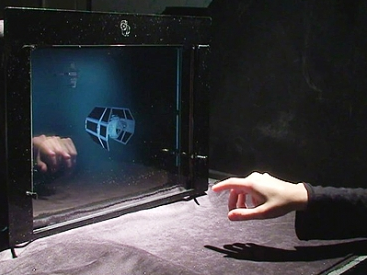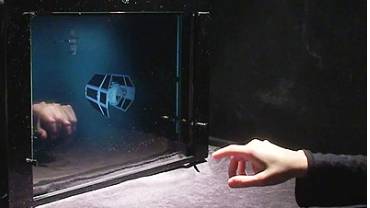Gestural interfaces make touch screens look so ‘last year’
Source: gizmag.com
The gestural interface used by Tom Cruise in the movie Minority Report was based on work by MIT Media Lab’s Hiroshi Ishii, who has already commercialized similar large-scale gestural interface systems. However, such systems comprise many expensive cameras or require the user to wear tracking devices on their fingers. To develop a similar yet cost effective gestural interface system that is within reach of many more people other researchers at MIT have instead been working to develop screens with embedded optical sensors to track the movement of the user’s fingers that could quickly make touch screens seem outdated.
A laboratory mockup of a thin-screen LCD display with built-in optical sensors
(Photo: Matthew Hirsch, Douglas Lanman, Ramesh Raskar, Henry Holtzman)
Touch screens, like those found in iPhones, use capacitive sensing, where the touch of a finger disrupts the electrical connection between sensors which determine the location of the touch. Gestural interfaces use embedded optical sensors to track the movement of the user’s fingers so they don't have to come into contact with the display.
Many have pegged gestural interfaces as the next big thing in computer interfaces, including Microsoft whose Project Natal uses a peripheral embedded with a small camera to capture gestural information. However, according to the MIT researchers, such systems are limited because the cameras are offset from the center of the screen and therefore don’t perform well at short distances, which limits their ability to provide a seamless transition from gestural to touch screen interactions. This can be overcome if the cameras are set far enough behind the screen, as they are in Microsoft’s SecondLight, but this makes the displays bulky and requires expensive hardware to render the screen alternately transparent and opaque.
“The goal with this is to be able to incorporate the gestural display into a thin LCD device” - like a mobile phone - “and to be able to do it without wearing gloves or anything like that,” says researcher Matthew Hirsch, a PhD candidate at the Media Lab says.
Hirsch, along with MIT Media Lab professors Ramesh Raskar and Henry Holtzman and visiting researcher Douglas Lanman, have instead been working on a project that uses embedded sensors to turn displays into giant lensless cameras that can recognize hand gestures.
Pinhole cameras solve the problem
For their system to work, the Media Lab researchers used an LCD display with an array of optical sensors right behind it. The liquid crystals are like a lens, displaying a black-and-white pattern that alternates to let light through to the sensors. Because the pattern alternates so rapidly with whatever the LCD is otherwise displaying – be it a game, a list of files, or whatever - the viewer never notices it.
Lanman explains that they could have used an array of liquid crystals to simulate a sheet of pinholes by having the central pixel in each 19-by-19 block being white (transparent) while the others are all black. The problem with this is that it would only allow a small amount of light to reach the sensors, and it would therefore require exposure times that are too long to be practical.
So in order to maximize the amount of light that reaches the sensors the team developed a block of pixels 19 x 19 that is subdivided into a regular pattern of black and white rectangles of different sizes. This configuration allows much more light to pass through because there are just as many white squares as black. The 19 x 19 blocks are all adjacent to each other and the pattern of black-and-white squares allows the system to computationally disentangle the overlapping images, capturing the same depth of information that a pinhole array would, but capturing it much more quickly.
New technology
The Media Lab team has had to mock up its own LCD with built-in optical sensors to test its approach because these screens are not yet available commercially. In experiments in the lab, the researchers showed that they could manipulate on-screen objects using hand gestures and move seamlessly between gestural control and ordinary touch screen interactions.
MIT news reports that Paul Debevec, director of the Graphics Laboratory at the University of Southern California's Institute for Creative Technologies, whose doctoral thesis led to the innovative visual effects in the movie The Matrix says: “I like this one [gestural interface] because it’s really integrated into the display. Everyone needs to have a display anyway. And it is much better than just figuring out just where the fingertips are or a kind of motion-capture situation. It’s really a full three-dimensional image of the person’s hand that’s in front of the display.”
Indeed, the researchers are already exploring the possibility of using the new system to turn the display into a high-resolution camera.
Ramesh Raskar, who directs the Media Lab’s Camera Culture Group, says that the idea that “every pixel has a computer behind it,” offers opportunities to re-imagine how humans and computers interact.
Article from: GizMag.com






















